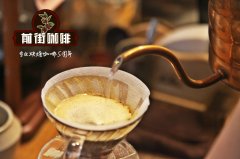Nicaragua Matagalpa Coffee Bean Flavor Description_Matagalpa Coffee Region Information

Professional coffee knowledge exchange more coffee bean information please follow the coffee workshop (Wechat official account cafe_style)
Nicaragua, located in central Central America, is a presidential republic. Nicaragua is bordered by Honduras to the north, Costa Rica to the south, the Caribbean Sea to the east and the Pacific Ocean to the west. Managua is the capital of the country. The climate of Nicaragua is high-temperature and rainy in the eastern plain, which belongs to the tropical marine climate; in the coastal lowlands of the west, the precipitation is obviously less than that in the east, and there are dry and wet seasons, so it belongs to the savanna climate; the average annual temperature in the central highlands is 18 degrees Celsius, with annual rainfall of 1500-2500 mm, with the rainy season from May to December. Nicaragua is also rich in resources. Nicaragua is one of the major gold-producing countries in Latin America, with 106 proven gold vein deposits with an annual output of 70,000 ounces, ranking 13th in the world. Its forest is also covered and accounts for 43% of the country's area, mainly exporting pine and mahogany.
Although Nicaragua is so rich in products, it is now one of the poorest countries in Central America. Due to its poor economic foundation, the country's coffee industry is also in a backward state, while coffee farmers are extremely poor. But fortunately, Nicaragua has received some foreign aid funds to improve the quality of coffee. The best Nicaraguan coffee trees grow in the northern and central parts of the country, with coffee from Matagalpa, Sinotega and Novo Segovia being the best.
Nicaragua has a suitable climate and mineral-rich volcanic soil, which also gives coffee trees a unique environment. Matagalpa, one of the best coffee producing areas here, produces coffee that is most popular with coffee lovers in the world and attracts the attention of the boutique coffee industry. Among them, the producing area has a heavyweight manor-lemon tree manor.
Lemon Tree Manor is located in the plateau of Matagalpa between 950 and 1300 meters above sea level. There are many towering coniferous forests around the coffee trees, which not only allows the coffee trees to be exposed to sunlight, but also protects the plants from being burned by the sun. Ervin Mirish, the current owner of the manor, let's start with one of the famous species of the manor, "Niaga Java", the full name of Niagara (Nicaraguan Java), but our landowner, Mr. Ervin (Niaga Java), is designed to distinguish it from Java on the island of Java. This bean won the second place in the 2008 Nicaragua Excellence Cup COE National Competition. The bid also surpassed the champion of that year, and Nika Java became famous in the first World War, after which Niagawa adopted a different method of sun treatment and peeling drying from the traditional water washing treatment. From delicate vanilla to tropical fruit spices, two different flavors of Nika Java have been added.
Nicaraguan coffee is among the highest in the world, it is mild and delicious, moderate granules, very fragrant. In many countries, coffee production has been seriously affected for political reasons. Nicaraguan coffee industry is no exception. The ruling government of Nicaragua in 1979 forced a large number of coffee growers to flee the country. A period of indecision followed, when the government considered whether to redistribute land, including many plantations, which led to a shortage of coffee and a decline in production, from more than 1 million bags in the early 1970s to less than 600000 bags in 1990. Now the government has opened up the coffee industry and private owners have taken control of the market. The best Nicaraguan coffee is grown in the north and middle of the country, and the best coffee is produced in Jinotega and Nuevo Segovia in Matagalpa. The finest Nicaraguan coffee is classified as Middle Estrich Tamant Altura (Central Estrictamendte Altura) coffee, which has moderate acidity, delicious aroma and is very lovable. Coffee beans of poor quality are widely used to mix coffee.
END
Important Notice :
前街咖啡 FrontStreet Coffee has moved to new addredd:
FrontStreet Coffee Address: 315,Donghua East Road,GuangZhou
Tel:020 38364473
- Prev

Guji producing area of Ethiopia | what is the flavor of native species in the Guracho Gulachu washing plant?
Professional coffee knowledge exchange more coffee bean information please follow the coffee workshop (Wechat official account cafe_style) Ethiopia Guji producing area | Guracho Gulachu washing plant local native flavor? The growers of this coffee come from small coffee farmers in two villages in the town of Guracho in Gulachu. The washing factory not only handles the cherry fruits very carefully, but also helps.
- Next

Nicaragua Coffee pola Bora producing area Information introduction _ Nicaragua Guapola Coffee beans how to drink
For more information on coffee beans, please follow the Coffee Workshop (official Wechat account cafe_style) Nicaragua is located in central Central America, bordering Honduras to the north, Costa Rica to the south, the Caribbean Sea to the east and the Pacific Ocean to the west, and Managua is the capital of the country. Lake Nicaragua, with an area of 8029 square kilometers, is the largest lake in Central America. It is a magical production of the sea.
Related
- Detailed explanation of Jadeite planting Land in Panamanian Jadeite Manor introduction to the grading system of Jadeite competitive bidding, Red bid, Green bid and Rose Summer
- Story of Coffee planting in Brenka region of Costa Rica Stonehenge Manor anaerobic heavy honey treatment of flavor mouth
- What's on the barrel of Blue Mountain Coffee beans?
- Can American coffee also pull flowers? How to use hot American style to pull out a good-looking pattern?
- Can you make a cold extract with coffee beans? What is the right proportion for cold-extracted coffee formula?
- Indonesian PWN Gold Mandrine Coffee Origin Features Flavor How to Chong? Mandolin coffee is American.
- A brief introduction to the flavor characteristics of Brazilian yellow bourbon coffee beans
- What is the effect of different water quality on the flavor of cold-extracted coffee? What kind of water is best for brewing coffee?
- Why do you think of Rose Summer whenever you mention Panamanian coffee?
- Introduction to the characteristics of authentic blue mountain coffee bean producing areas? What is the CIB Coffee Authority in Jamaica?

